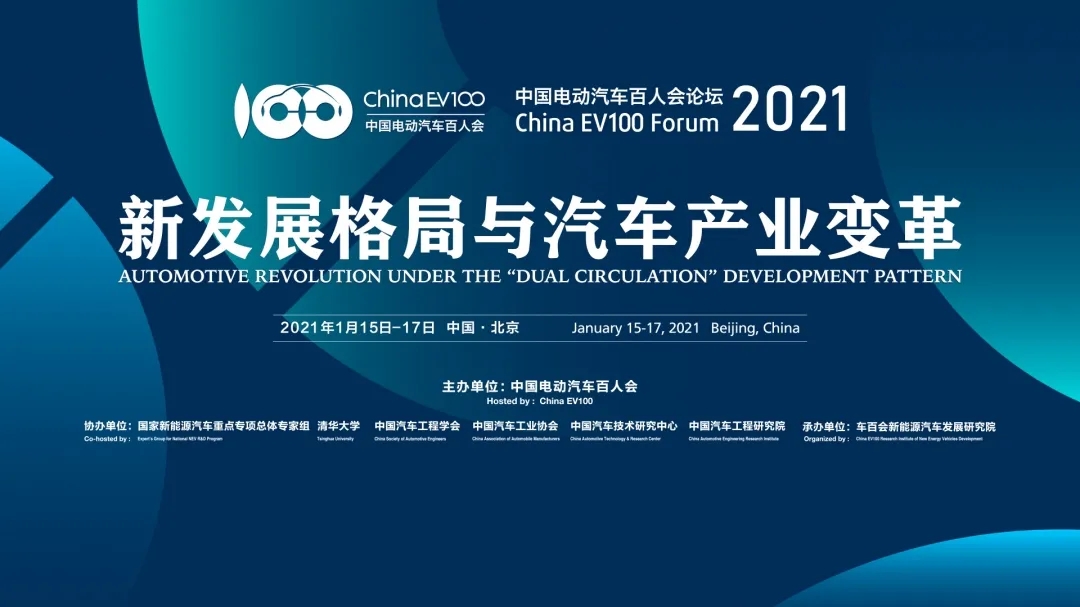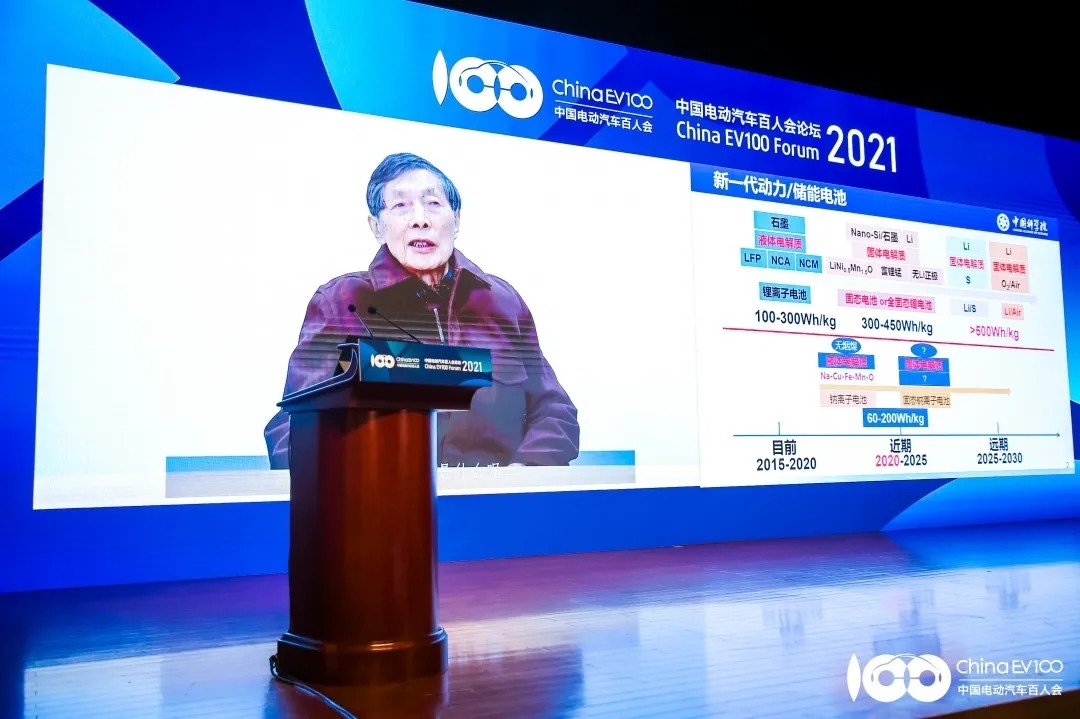
In 2021, at the beginning of the 14th Five-Year Plan, the international commitment of "carbon peak by 2030 and carbon neutral by 2060" has been made, and the automobile revolution is moving towards the middle and advanced development stage with intelligence and network as the core... From January 15 to 17, 2021, the 7th China Electric Vehicle 100 Forum was held online in Diaoyutai State Guesthouse. The theme of the forum was "New Development Pattern and Automotive Industry Reform", which attracted much attention. Chen Liquan, an academician of the Chinese Academy of Engineering, delivered a keynote speech at the Future Battery Forum on the morning of January 17. Following is Academician Chen's speech:

Chen Liquan: Hello everyone! I am Chen Liquan from the Institute of Physics, Chinese Academy of Sciences. On behalf of my colleagues Li Hong, Hu Yongsheng, Yu Huigen from Weilan New Energy and Luo Fei from Tianmu Pioneer, I would like to communicate with you. The topic of my exchange today is "New Generation Battery, Leading Electric China".
What are the current batteries? The current battery is lithium-ion battery, which is the familiar graphite negative electrode, and then lithium iron phosphate or ternary or lithium cobalt acid as the positive electrode. The electrolyte is a flammable liquid electrolyte, which can easily cause safety concerns. In addition, its energy density is up to 300 watt-hours/kg, which has reached the limit of liquid lithium-ion battery. Our next step or the next generation of batteries is going to be solid-state batteries or we're going to move gradually to all-solid-state lithium batteries.
Our present form of energy must be described. At present, China's energy resources are rich in coal, short of gas and short of oil, and we are in short of oil. In 2018, coal, oil and natural gas accounted for 85.6 percent of China's total energy, while water, wind, light and nuclear energy accounted for 18.3 percent. It is fair to say that fossil fuels are the main source of energy. Our production of crude oil is 2018, 190 million tons of imported crude oil is 460 million tons, have external dependency is 71%, we suggest that the original external dependency not more than 50%, in fact has been far more than 50%, the ownership of cars is 240 million, if a car is an average of 2 tonnes of oil, then we imported 460 million tons of crude oil is enough in our cars, so we must electric China, to develop electric cars, so to replace the imported oil, which is why we want to transportation electrification. At the same time, to achieve intelligent devices, intelligent devices must also need batteries.
In addition, President Xi called for the construction of a global energy Internet to meet the world's electricity demand in a clean and green way. It also recently pointed out that for our carbon emissions to peak by 2030, a 25% share of non-fossil energy would be needed, and more than 1.2 gigawatts of wind and solar power would be installed. In 2020, we have 500 GW, so we have to add 0.7 GW every year for the next 10 years, so the task is quite daunting, we have to be carbon neutral by 2060, which is the date that President Xi recently announced for our China.
So we must put special emphasis on the energy Internet, the energy Internet can achieve low carbon energy. So to develop the energy Internet, we must need energy storage. Now, one is lithium ion battery, the other is sodium ion battery, so this is the importance of the new generation of batteries.
The following is an introduction to transportation electrification, including several aspects:
The first one, electric cars, this is a very familiar one, we've been planning electric cars since 2000.
Second, we must pay attention to electric ships at present. The sulfur emission of a 10,000-container ship is equivalent to 150,000 heavy trucks, which is very serious for environmental pollution. Therefore, we must develop electric ships, especially ocean-going ships. We can develop unmanned electric ships.
Third, electric aircraft. Recently, China has held a conference on electric aviation in China for three consecutive years from 2017. Therefore, the development of electric aircraft is a direction of our future development.
Because these three things -- electric cars, electric ships, and electric planes -- are all important to improving the environment.
The energy Internet has five characteristics. First, the energy used is all renewable energy. Second, it's distributed and decentralized. The third one is interconnection. If you want to build a network, you have to connect it. Fourthly, after the network is connected, it will be open. You can sell the excess energy at any time, and you can also buy the needed energy from the Internet. It is open. Number five, this is intelligent, it's all controlled by intelligence. These five characteristics must all need batteries, one is lithium ion battery, one is sodium ion battery.
The current lithium-ion battery, which I just described, is a liquid electrolyte, the negative electrode is graphite, and the positive electrode is an oxide with a transition metal or something like that.
It has an energy density limit of 300 wh/kg or a little bit higher, and safety accidents happen, fires and explosions, so we're going to develop solid-state lithium batteries or all-solid-state lithium batteries, with lithium metal as the cathode. At this stage, instead of lithium metal, the anode can be made of nano silicon or silicon carbon composites. The anode can make use of the existing cheaper containing transition metal anode material, at the same time can also be the future development of excluding the anode material of lithium, in the middle of the electrolyte is solid, can is oxide, sulfide, can also be polymer, we now are in situ solid-state, below I speak what is in situ solid-state, energy density can be as high as 350-500 watts/kg, not burning, not explosion, security is higher.
The Institute of Physics has actually been working on solid state batteries for a long time, we've been working on solid electrolyte materials since 1976. Since then, we have never stopped studying solid electrolyte. Recently, we have discovered some new materials from calculation. At the same time, we have also done a lot of work on the safety of solid-state battery, and found that the safety of solid-state battery is very good. In 2018, the energy density of the solid-state battery reached 300 Wh/kg. In addition, we carried out the test of the prototype vehicle and set up a production base in Liyang in 2019. Now the solid-state battery products have been supplied for the use of unmanned aerial vehicles, and the battery safety has passed the test. Its raw materials, including the silicon carbon anode, are being mass-produced, as are the membranes coated with solid-state electrolytes needed for solid-state batteries.
The following is a special introduction to in-situ solid state. The upper part of the image is the collector of the copper foil, the black is the anode side, the anode material is nano silicon or silicon carbon negative, and the lower green color is the LATP coating on the diaphragm, which is the electrolyte material that keeps the liquid electrolyte solid in situ. It can also be seen that after charging and discharging several times, the surface of the anode material, that is, the black particle surface, is coated with a SEI film. On the surface of the diaphragm, coated with a layer of LATP, it also becomes a solid electrolyte with SEI film. The positive electrode, negative electrode and electrolyte are completely integrated, which is in situ solid-state.
This diagram shows the circulatory stability of the membrane coated with alumina and LATP solid electrolyte respectively. It can be seen that the membrane coated with alumina has poor circulatory performance, while the membrane coated with LATP solid electrolyte has good circulatory performance. This is at present our solid state battery some process more detailed situation.
These are some new products of Veilan New Energy. In the new products, I would like to emphasize that the energy density of this battery can reach 1540 wh/l, which is the highest volume energy density in the world at present. Its weight energy density can reach 600 wh/kg, and its battery capacity is 25 amph.
This diagram shows a 300 Wh/kg high specific energy hybrid solid-liquid power battery with a capacity of 58 A h and an energy density of 300 Wh/kg. On the upper right is a liquid electrolyte battery, which can catch fire and explode when punctured, while a solid battery can. This shows its temperature, which doesn't change much at all. This is the puncture voltage, and you can see that the red line, as soon as the pin is put in it goes down, but after a while the voltage comes back up. This is the cycle of a 58Ah battery, with a 1400 week capacity retention rate of 80%. In addition, it is also very good at low temperature performance, the red line is low temperature performance, minus 20 degrees of capacity retention rate can be 78%. Multiplier characteristics are also quite good, 0.2C up to 3C, basically small capacity change.
This is a 400Wh/kg high specific energy solid state battery, it has a battery capacity of 11 Amh, the battery condition in the middle, and the 0.3C cyclicity condition in the top right corner. And you can see that it's also pretty safe, because when the nail goes in, the voltage goes up while the nail is still in it. The temperature rise during needling is very small, about two or three degrees (the black and red lines are the temperature conditions on both sides of the positive and negative poles), so a 400Wh/kg high-energy solid state battery is also safe.
This shows Weigo Innovation Technology, a subsidiary of Weilan New Energy, a company founded by the Institute of Physics, which won four first prizes in a competition last year. It shows the first-prize battery with high energy density: 0.2C, with an energy density of 610 Wh/kg; 2C, the energy density can go up to 500 Wh/kg, so it's pretty high.